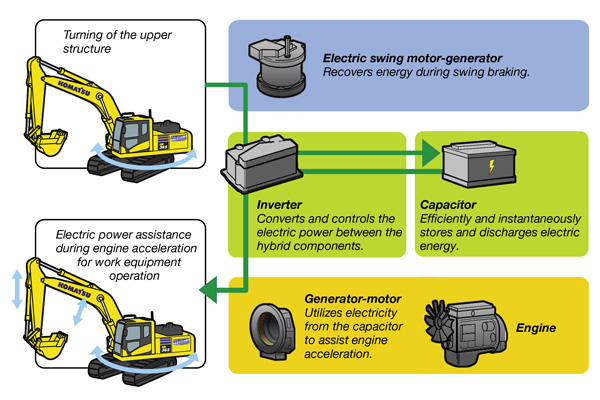
After over 20 years of continuous development, 3 generations of machines, 9 years of sales, Komatsu Hybrid machines total well over 3 million working hours in Europe.
The original 21 tonne HB215 and the more recent 36 tonne HB365, are proven cost effective alternatives to conventional hydraulic excavators.
 What & How?
What & How?
A Komatsu Hybrid excavator utilises two power sources.
Hydraulic power supplies the boom and arm for digging operations, and the travel motors for travelling. Electrical power drives the swing system to rotate the machine’s upper structure.
The electrical energy required to rotate the upper structure is recovered kinetic energy, when braking the upper structure, or is harvested from spare engine capacity.
Whilst the technology deployed in a Hybrid excavator is extremely advanced, the implementation of the technology is incredibly simple:
- Electric generator-motor between the engine and the hydraulic pump.
- Electric swing motor-generator.
- Inverter & ultra-capacitor assembly.
The fully electric Komatsu hybrid system employs regenerative braking, via the swing generator-motor, to transform kinetic energy, during swing deceleration, into electrical energy that is stored in the ultra-capacitor. The recovered energy stored in the ultra-capacitor, can then power the electrical swing system, or help accelerate the diesel engine through the motor-generator mounted between the engine and pump. Additionally, the diesel engine’s generator-motor can also charge the ultra-capacitor.
Why use an ultra-capacitor rather than batteries?
Ultra-capacitors provide numerous advantages over batteries.
- An ultra-capacitor offers a significantly faster charge and discharge response than a battery. This means that an ultra-capacitor can respond to construction equipment peak energy demands without compromise.
- Ultra-capacitor performance does not diminish over the machine lifetime whilst battery performance tends to reduce over time / number of cycles.
- Ultra-capacitor response, and performance is independent of temperature. Battery performance tends to diminish, particularly at low temperatures.
 Ultra-capacitors offer high power density versus volume, compared to energy storage methods such as battery. This means that space, weight, performance, and ultimately machine life, are optimised. Typical power density is typically 10 times that of batteries, with close to 100% efficiency due to negligible internal resistance.
Ultra-capacitors offer high power density versus volume, compared to energy storage methods such as battery. This means that space, weight, performance, and ultimately machine life, are optimised. Typical power density is typically 10 times that of batteries, with close to 100% efficiency due to negligible internal resistance.- The Ultra-capacitor, and its manufacturing process, does not involve the use of harmful chemicals or toxic materials.
An environmentally friendly machine
Komatsu’s objective when starting the development, way back in 1999, was not to produce a “hybrid” excavator; the objective was to produce a machine that was kinder to the environment and provided reduced running costs compared to a conventional hydraulic excavator.
After nearly 10 years of research, development, and extensive testing, the “PC200-8 Hybrid” , the world’s first commercial hybrid excavator was born. Launched in Japan in 2008 it would be a few years later, when the 2nd generation was launched, that hybrid excavators made it to Europe. With the global launch of the new Hybrid brand and a new “HB” prefix to differentiate it within the Komatsu product range, the HB215LC-1 was introduced to the Europe in 2011.
Continuous improvement
Komatsu’s ethos of continuous improvement prompted the development and release of new machines in the HB215 range in 2014 and 2018. Requests from the market for a larger machine led to the launch of the HB365, a 36t class excavator, in 2016.
If the objective was to be kinder to the environment and reduce running costs, what effect are Komatsu Hybrid machines having?
With an average fuel saving of >20% over conventional hydraulic excavators, the 1,000 Komatsu Hybrid excavators in Europe have:
- Saved customers over 11 Million litres of fuel
- Reduced customers’ fuel bills by more than 11 Million Euros
- Reduced CO2 emissions by more than 28,000 tonnes.
The 28,000 tonnes of CO2 emissions reduction being more than the combined weight of the 1000 Hybrid excavators sold in Europe!
Summary
Since the launch of Komatsu’s Hybrid machines, the early adopters of this pioneering technology have not only spread the word amongst their peers, promoting acceptance of this unique technology, they have also returned, time after time, for replacement or additional Hybrid machines. The proven Komatsu reliability has broken down barriers, and sales continue to increase year on year. Dream-like fuel consumption rates turned theory into reality, saving owners thousands of Euros each year.
During these times of environmental focus and carbon footprint reduction, the undeniable environmental benefits provided by Komatsu Hybrid excavators help to reduce the construction industry’s impact on the air that we all live in and breathe. Thank you Komatsu!
Content produced in association with Komatsu Europe











